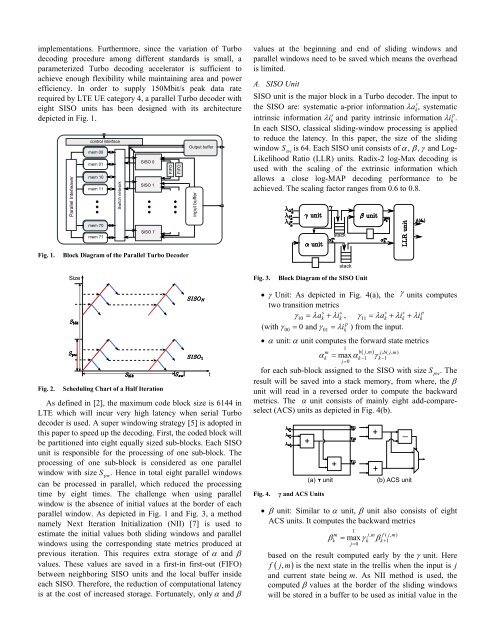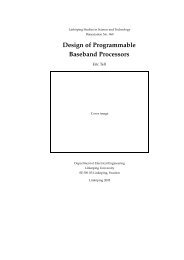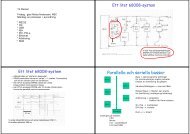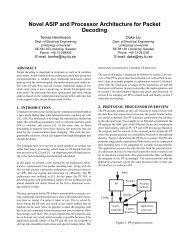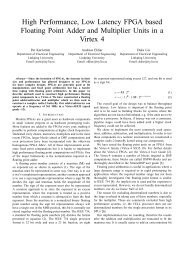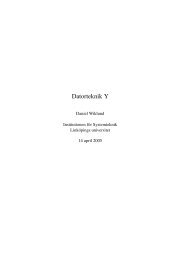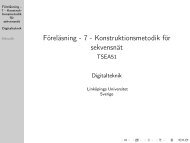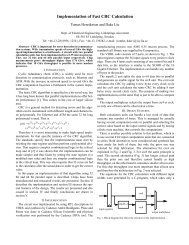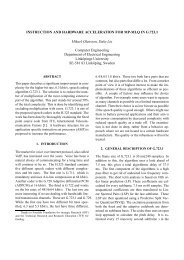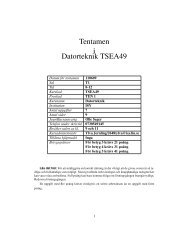Implementation of A High-Speed Parallel Turbo Decoder for 3GPP ...
Implementation of A High-Speed Parallel Turbo Decoder for 3GPP ...
Implementation of A High-Speed Parallel Turbo Decoder for 3GPP ...
Create successful ePaper yourself
Turn your PDF publications into a flip-book with our unique Google optimized e-Paper software.
implementations. Furthermore, since the variation <strong>of</strong> <strong>Turbo</strong><br />
decoding procedure among different standards is small, a<br />
parameterized <strong>Turbo</strong> decoding accelerator is sufficient to<br />
achieve enough flexibility while maintaining area and power<br />
efficiency. In order to supply 150Mbit/s peak data rate<br />
required by LTE UE category 4, a parallel <strong>Turbo</strong> decoder with<br />
eight SISO units has been designed with its architecture<br />
depicted in Fig. 1.<br />
values at the beginning and end <strong>of</strong> sliding windows and<br />
parallel windows need to be saved which means the overhead<br />
is limited.<br />
A. SISO Unit<br />
SISO unit is the major block in a <strong>Turbo</strong> decoder. The input to<br />
s<br />
the SISO are: systematic a-prior in<strong>for</strong>mation λ a k , systematic<br />
intrinsic in<strong>for</strong>mation λ i s k and parity intrinsic in<strong>for</strong>mation λ i p<br />
k .<br />
In each SISO, classical sliding-window processing is applied<br />
to reduce the latency. In this paper, the size <strong>of</strong> the sliding<br />
window S sw is 64. Each SISO unit consists <strong>of</strong> α , β , γ and Log-<br />
Likelihood Ratio (LLR) units. Radix-2 log-Max decoding is<br />
used with the scaling <strong>of</strong> the extrinsic in<strong>for</strong>mation which<br />
allows a close log-MAP decoding per<strong>for</strong>mance to be<br />
achieved. The scaling factor ranges from 0.6 to 0.8.<br />
Fig. 1.<br />
Block Diagram <strong>of</strong> the <strong>Parallel</strong> <strong>Turbo</strong> <strong>Decoder</strong><br />
Fig. 3.<br />
Block Diagram <strong>of</strong> the SISO Unit<br />
Fig. 2.<br />
Scheduling Chart <strong>of</strong> a Half Iteration<br />
As defined in [2], the maximum code block size is 6144 in<br />
LTE which will incur very high latency when serial <strong>Turbo</strong><br />
decoder is used. A super windowing strategy [5] is adopted in<br />
this paper to speed up the decoding. First, the coded block will<br />
be partitioned into eight equally sized sub-blocks. Each SISO<br />
unit is responsible <strong>for</strong> the processing <strong>of</strong> one sub-block. The<br />
processing <strong>of</strong> one sub-block is considered as one parallel<br />
window with size S pw<br />
. Hence in total eight parallel windows<br />
can be processed in parallel, which reduced the processing<br />
time by eight times. The challenge when using parallel<br />
window is the absence <strong>of</strong> initial values at the border <strong>of</strong> each<br />
parallel window. As depicted in Fig. 1 and Fig. 3, a method<br />
namely Next Iteration Initialization (NII) [7] is used to<br />
estimate the initial values both sliding windows and parallel<br />
windows using the corresponding state metrics produced at<br />
previous iteration. This requires extra storage <strong>of</strong> α and β<br />
values. These values are saved in a first-in first-out (FIFO)<br />
between neighboring SISO units and the local buffer inside<br />
each SISO. There<strong>for</strong>e, the reduction <strong>of</strong> computational latency<br />
is at the cost <strong>of</strong> increased storage. Fortunately, only α and β<br />
• γ Unit: As depicted in Fig. 4(a), the γ units computes<br />
two transition metrics<br />
s s s s p<br />
γ10 = λak + λik , γ11<br />
= λak + λik + λik<br />
p<br />
(with γ 00 = 0 and γ 01 = λi k ) from the input.<br />
• α unit: α unit computes the <strong>for</strong>ward state metrics<br />
1<br />
( , ) , ( , )<br />
α m max<br />
b j m j b j m<br />
k = αk<br />
− 1<br />
γ k − 1<br />
j=<br />
0<br />
<strong>for</strong> each sub-block assigned to the SISO with size S pw<br />
. The<br />
result will be saved into a stack memory, from where, the β<br />
unit will read in a reversed order to compute the backward<br />
metrics. The α unit consists <strong>of</strong> mainly eight add-compareselect<br />
(ACS) units as depicted in Fig. 4(b).<br />
Fig. 4.<br />
γ and ACS Units<br />
• β unit: Similar to α unit, β unit also consists <strong>of</strong> eight<br />
ACS units. It computes the backward metrics<br />
1<br />
m j, m f ( j, m)<br />
k = max k k 1<br />
j=<br />
0<br />
β γ β +<br />
based on the result computed early by the γ unit. Here<br />
f ( jm , ) is the next state in the trellis when the input is j<br />
and current state being m. As NII method is used, the<br />
computed β values at the border <strong>of</strong> the sliding windows<br />
will be stored in a buffer to be used as initial value in the


